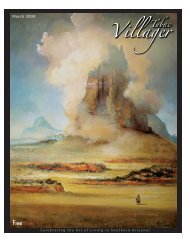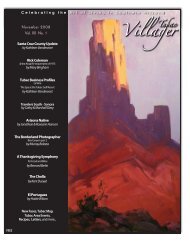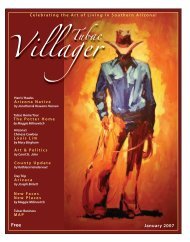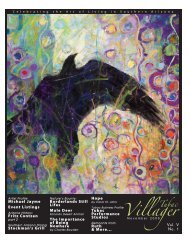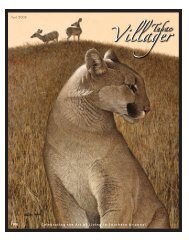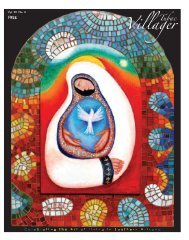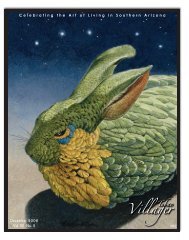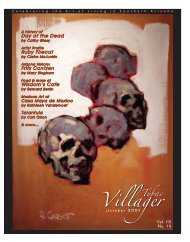You also want an ePaper? Increase the reach of your titles
YUMPU automatically turns print PDFs into web optimized ePapers that Google loves.
y Mary Bingham<br />
S o u t h e r n A r i z o n a H i s t o r y<br />
Didier Masson & El Biplano Sonora<br />
Friend Delia Medina Salinas recently brought this bit of early<br />
20th century history to my attention. Delia has ties to the<br />
<strong>Tubac</strong>-Tucson area through her ancestor Lieutenant Colonel<br />
and Adjutant Inspector of the Internal Provinces of New Spain,<br />
Don Roque de Medina. Th at was way back when the Internal<br />
Provinces included present-day Southern Arizona and Northern<br />
Sonora, Mexico.<br />
However, this story begins in California, probably in early<br />
March or April of 1913. Delia’s grandfather Juan Pablo Medina<br />
and his daughter, María Medina, participated in a most unusual<br />
historic event – the fi rst aerial bombing of navel vessels in<br />
North America. Señor Medina was an astute businessman from<br />
Cananea, Sonora, and María a student attending college in<br />
California. She was fl uent in English and French, which was<br />
vital to the success of their mission.<br />
On February 18, 1913, Mexico once again became a state<br />
in turmoil when General Victoriano Huerta overthrew the<br />
Constitutionalist government of President Francisco I. Madero.<br />
President Madero and Vice President José María Pino Suárez<br />
were seized in the National Palace of Mexico City, the offi cial<br />
seat of government, and placed under arrest. Four days later<br />
on February 22nd the two were assassinated in what Huerta<br />
claimed was “crossfi re between Madero’s captors and would-be<br />
rescuers.”<br />
General Álvaro Obregón, a loyal supporter of Madero, dismissed<br />
Huerta’s ridiculous claim and dedicated himself to taking<br />
Mexico back from the ruthless dictator. Señor Medina and<br />
María felt the same. At Obregón’s request, two trusted military<br />
offi cials, Colonel Santiago Camberos and Captain Joaquín<br />
Bauche Alcalde accompanied by Señor Medina traveled to<br />
California to purchase an aeroplane. Medina arranged for María<br />
to join them and act as translator.<br />
Th e “hero” of this tale is French-born aviator Didier Masson.<br />
Born in Asnières, France on February 23, 1886, he apprenticed<br />
as a jeweler, but became a magneto repairman while serving in<br />
the French military. Louis Paulhan, one of France’s early aviators,<br />
hired Masson as a mechanic in 19<strong>09</strong> when he returned to civilian<br />
life. Masson quickly learned to fl y and soloed that same year.<br />
Paulhan and Masson decided to travel to America where<br />
aviation was growing at an incredible pace. Masson sailed for<br />
America arriving on December 27, 19<strong>09</strong>, followed by Paulhan<br />
and his family who arrived on January 3, 1910. Both participated<br />
in air shows and early barnstorming events.<br />
Masson caught the eye of Ivan R. Gates, owner of the fl edgling<br />
Gates Flying Circus in 1912. When Gates was injured in an auto<br />
accident, he hired Masson to fulfi ll his show contracts. Masson<br />
quickly became a sensation. Later that year, he was hired by<br />
Glenn Martin as an instructor at Th e Glenn Martin Flying<br />
School and ironically received his fi rst pilot’s license, #202 issued<br />
by the Aero Club of America.<br />
Th e school was a part of the California division of the Glenn<br />
L. Martin Company established in 1912 at Dominguez<br />
Field near Los Angeles. It was here that Camberos, Alcalde,<br />
and the Medinas met the dashing Frenchman. Masson was<br />
immediately smitten by the beautiful María and took her for<br />
a demonstration ride. After the ride, María translated for the<br />
Some historians identify the plane fl own by Masson as a<br />
Martin Pusher, while others say it was a Curtiss Pusher.<br />
A pusher type aircraft has its engine and propeller located<br />
to the rear of the pilot, as in this painting by <strong>Tubac</strong> Artist<br />
Walter Wilson, courtesy of the <strong>Tubac</strong> Art Exchange.<br />
offi cials outlining their plans to purchase an aeroplane that could<br />
provide intelligence on enemy troop movements and ultimately<br />
bomb Huerta’s navel ships at the port of Guaymas on the Sea of<br />
Cortez.<br />
Masson was intrigued at the prospect of bombing a ship from<br />
the air. He was sure that it had never been done before. He was<br />
also intrigued by the beautiful, French speaking, María! Masson<br />
took the visitors across the airfi eld to see Martin, and a biplane<br />
known as a Martin Pusher was quickly purchased with the<br />
deal to include Martin’s top pilot, Masson, and top mechanic,<br />
Australian born Th omas James Dean. Both were to be paid well<br />
for their services with a salary of $300 per month, plus $50 for<br />
each exploratory fl ight and $250 for each bombing raid. Th e<br />
Martin biplane reportedly cost $5000, which Delia believes was<br />
fi nanced by her grandfather.<br />
Th ere is much confusion over the manufacturer of the biplane.<br />
Some historians identify the plane as a Martin Pusher, while<br />
others say it was a Curtiss Pusher. Both manufactures were<br />
located in Southern California and designing similar aircraft<br />
at the time. Th e Curtiss facility was located in San Diego with<br />
seaplane operations at Corona del Mar, while Martin had<br />
facilities near Los Angeles and seaplane operations at Balboa<br />
Island in Newport. It is possible that the Mexican offi cials visited<br />
both builders.<br />
A couple of historians have even identifi ed the biplane as a<br />
Martin Pusher with a Curtiss engine. Photographs of Masson<br />
and the biplane can be found on the Internet. To this writer’s<br />
untrained eye, it looks like a Martin Pusher. Perhaps a Curtiss<br />
replacement engine was used at a later date. Th e biplane that<br />
many described as looking like a mosquito, was quickly dubbed<br />
“El Biplano Sonora” named for the Mexican state of Sonora.<br />
Hermosillo, Sonora would be its fi rst destination.<br />
Now the problem was how to smuggle the biplane into Mexico<br />
without either U.S. or Mexican authorities intercepting it. Th e<br />
U.S. had placed an embargo on war materials headed to Mexico,<br />
and aircraft of any type were considered weapons of war. Wells<br />
Fargo crated the plane in fi ve crates and shipped it to Tucson<br />
via train. Masson and Dean arranged for wagons and mules and<br />
began the trip south that would take them through <strong>Tubac</strong> and<br />
past the old Tumacacori Mission en route Nogales. Th ere wasn’t<br />
much else in between Tucson and Nogales back then.<br />
May 9th the Casa Grande Dispatch datelined Los Angeles<br />
reported that Didier Masson and his mechanic, Th omas Dean<br />
had been arrested and charged with violation of neutrality laws<br />
the previous day. An unnamed U.S. district attorney was quoted<br />
as saying, “the plans were known since the Mexicans opened<br />
negotiations to purchase fl ying machines for use in the war<br />
against Huerta.”<br />
Meanwhile the New York Times for the same date reported that<br />
a Deputy Marshal Johnson at Pike’s Ranch, twenty miles south<br />
of Tucson had captured a war aeroplane. Masson and Dean<br />
claimed they were merely planning to test the machine and were<br />
looking for a good place to do so. Th e name of the arresting<br />
offi cer may be incorrect as there is no record of a U. S. Deputy<br />
Marshal named Johnson in Arizona in 1913. Th e most likely<br />
arresting offi cer was U. S. Deputy Marshal Arthur A. Hopkins<br />
who shows up later in the story. Haven’t been able to pinpoint<br />
the Pike Ranch either, but 20 miles south using the Old Nogales<br />
Highway would have put it right around the current border<br />
between Sahuarita and Green Valley. Perhaps near the new Wal-<br />
Mart on Duval Mine Road.<br />
By May 10th, Th e Ogden Examiner headline proclaimed:<br />
UNCLE SAM SEEKS BIRD MEN WHO FLEE COUNT.<br />
Th e story goes on to say Masson and Dean were reported to have<br />
crossed the border at Nogales wearing constitutionalist army<br />
uniforms.<br />
May 11th, the Galveston Daily News with a Nogales, Ariz.,<br />
dateline reported:<br />
Evidencing that still another war aeroplane is being smuggled<br />
over the border to assist in the attack on Guaymas, a huge roll<br />
was received by express today at Nogales, Sonora. It was claimed<br />
by Didier Masson, the French aviator, who narrowly escaped<br />
arrest below Tucson, Ariz., where his aeroplane was held by<br />
United States federal authorities.<br />
Masson said the packages contained the vital parts of an<br />
continued on page 28...




